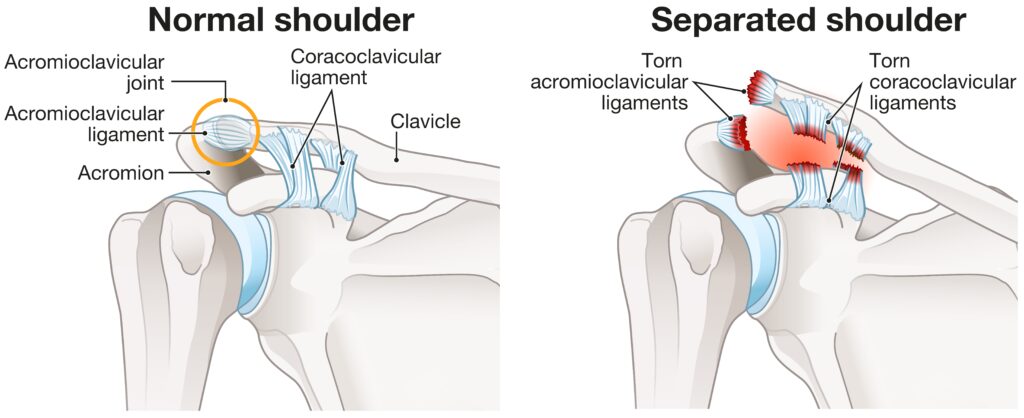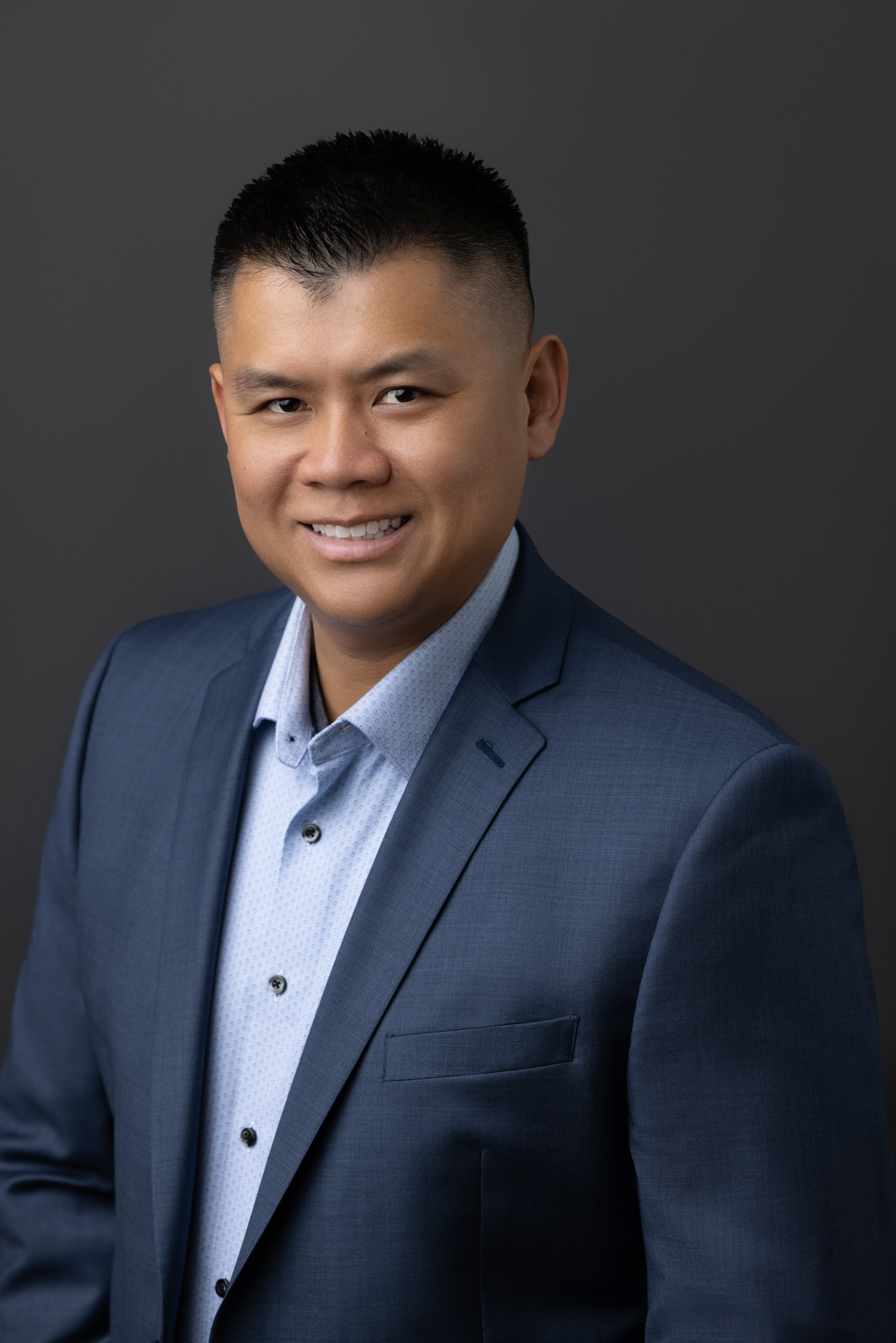The acromioclavicular, or AC joint, is a joint in the shoulder where the collarbone (clavicle) and the shoulder blade (scapula) meet. The end of the scapula is called the acromion. Like most joints in the body where bones meet, there is white tissue between the bones known as cartilage that allows movement on each other. An acromioclavicular joint separation or AC joint separation occurs when the clavicle separates from the scapula either by the ligaments or cartilage stretching or tearing.
In this blog I will discuss what causes an AC joint separation, the symptoms and treatment options available.

What causes an AC joint separation?
AC joint separations are almost always caused by a sudden traumatic event such as a direct blow to the shoulder (often seen in football or hockey) or a fall on an outstretched arm (such as falling from a bike or horse). An AC joint separation involves damage to the ligaments that support the AC joint, considered either a sprain or tear. These separations can range in severity from minor stretching of the ligaments to complete tearing of these ligaments and cartilage.
- The least severe AC separation is classified as a mild sprain where typically there is no visible deformity and X-rays of the shoulder appear normal.
- The second, more serious category include tears in the AC ligament and sprains in the coracoclavicular (CC) ligament. There is an easily visible bump, and the clavicle and shoulder blade are often misaligned.
- The third and most severe form of this injury involves both the AC and the CC ligaments being torn. There will be a large external deformity (bump) present, including the clavicle and shoulder blade being visibly misaligned.
Symptoms
Because AC joint separations are commonly caused by falls or direct trauma to the AC joint, obvious initial pain and soreness will follow. The most common symptom of an AC joint separation is extended pain and tenderness in your shoulder, especially when you lift or press on it. You may also experience swelling and bruising around the AC joint. A more severe injury to the AC joint will result in a visible deformity or bump, easily seen at the top of the shoulder that will likely be tender to touch or move.
How is an AC joint separation diagnosed and treated?
AC joint separations are usually easy to diagnose through a simple physical examination. A separation is often apparent from hearing how the injury occurred as well as the external appearance of the shoulder. An X-ray or MRI may be taken to ensure there is no fracture of these bones.
Treatment may include rest, ice, anti-inflammatory medications, and if necessary, a brace for immobilization. Depending on the severity of the joint separation, surgery may be necessary to repair torn ligaments or cartilage in order to restore appropriate shoulder positioning and function. Surgery may also be an option if an AC joint separation has not responded well to non-operative treatments.
When addressed early after the injury, often times the surgery can involve just a repair of the ligament to allow your own tissue to scar in place. When severe separations are left unattended for too long, a reconstruction with cadaveric donor tissue (allograft) may be required. Your orthopedic surgeon will discuss these options with you and help you find the best treatment for your specific case.
Can an AC joint separation heal on its own?
Depending on the severity, many AC joint injuries will heal on their own with rest and proper treatment.
Some at home treatments steps you can use include:
- Rest
- Ice
- Anti-inflammatory medications
- Immobilizing with a sling
Recovery
Recovery time depends on the severity of the injury but can range from several weeks to several months. Fortunately, with time and proper treatment, most AC joint injuries heal successfully.
It is important to understand that while resting your shoulder is a necessary step for allowing an AC joint to heal, resting for any length of time may likely cause a gradual decrease in muscle strength and mobility. Therefore, rehabilitation will help you regain what you’ve lost during your recuperation period. Exercises involving stretching and strengthening, with the assistance of a physical therapist, can play a critical role in fully restoring the health of your shoulder and upper arm.
Preventing an AC joint separation
Preventing an AC joint separation altogether may not be fully avoidable however, it is possible to lower the risk in some instances. Strengthening exercises and proper stretching is especially important for athletes to help prevent AC joint separations. These should be taken very seriously to prevent injury because supple ligaments are far less likely to stretch or be injured than tight, stressed ligaments. Wearing proper protective gear is critical when engaging in contact sports such as football, rugby, or hockey. It is also important to recognize exhaustion. When you are overtired or have pushed your body beyond its limits, you become more susceptible to injury.
Knowing the signs and symptoms of AC joint separation, as well as how to prevent it, can help you stay safe and avoid injury. If you suspect that you or someone else has an AC joint separation, seek medical attention from an orthopedic surgeon. Early diagnosis and treatment are key for a successful recuperation.
FAQs
Q: What is an AC joint separation?
A: An acromioclavicular joint separation or AC joint separation, occurs when the ligaments and/or cartilage that hold together the acromioclavicular (AC) joint in your shoulder are stretched or torn, causing the clavicle to separate from the scapula.
Q: What causes and AC joint separation?
A: AC joint separations are almost always caused by a sudden traumatic event such as a direct blow to the shoulder (often seen in football or hockey) or a fall on an outstretched arm (such as falling from a bike or horse). An AC joint separation involves damage to the ligaments supporting the AC joint, either a sprain or tear.
Q: How is an AC joint separation diagnosed and treated?
A: AC joint separation is usually diagnosed through a physical examination and imaging tests like an X-ray or MRI. Treatment may include rest, ice, anti-inflammatory medications, and the use of a brace for immobilization. In some cases, depending on the severity, surgery may be necessary to repair torn ligaments or cartilage.
Q: Can an AC joint separation heal on its own?
A: Most AC joint separations will heal on their own with rest and proper treatment. Recovery time depends on the severity of the injury but can range from several weeks to several months.
Q: Can you prevent an AC joint separation?
A: Preventing an AC joint separation altogether may not be fully avoidable however, it is possible to lower the risk in some instances. Strengthening exercises and proper stretching can also help prevent AC joint separations. Wearing proper protective gear when engaging in contact sports such as football, rugby, or hockey is also critical.
Q: How serious is an AC joint separation?
A: AC joint separation severity can range from a mild sprain to a complete AC joint dislocation. In severe cases, AC joint separations may require surgery or a longer treatment and recovery process. Regardless of the severity, AC joint separations should be treated promptly in order to avoid any further damage.
Q: Should I do exercises for an AC joint injury?
A: Rehabilitation exercises for an AC joint sprain or separation will depend on the severity of the injury. Exercises should begin only when the ligaments have healed, and you have no pain during normal daily activities.
Q: Can I continue to work out if I have an AC joint separation?
A: It is important to listen to your body and consult your doctor if you are experiencing AC joint pain. Depending on the severity, you may need to modify or temporarily stop activities such as lifting weights or contact sports until the injury has healed.
Dr. Giang specializes in shoulder injuries and would be happy to assist you with treatment options. Please give us a call or complete the form below to set up a consultation.
"*" indicates required fields






